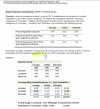navjyotbirdy
New Member
Hi @David Harper CFA FRM Can you give more explanation to the example in the study notes of Probabilities, I have highlighted my doubts in yellow. 
I don't understand on 39.13*75(which is conditional beats of first year?)
Thanks
Navjyot

I don't understand on 39.13*75(which is conditional beats of first year?)
Thanks
Navjyot


